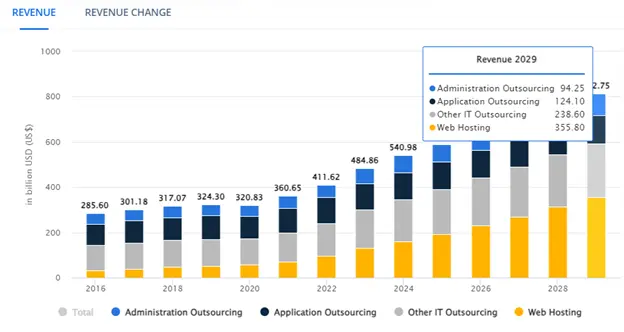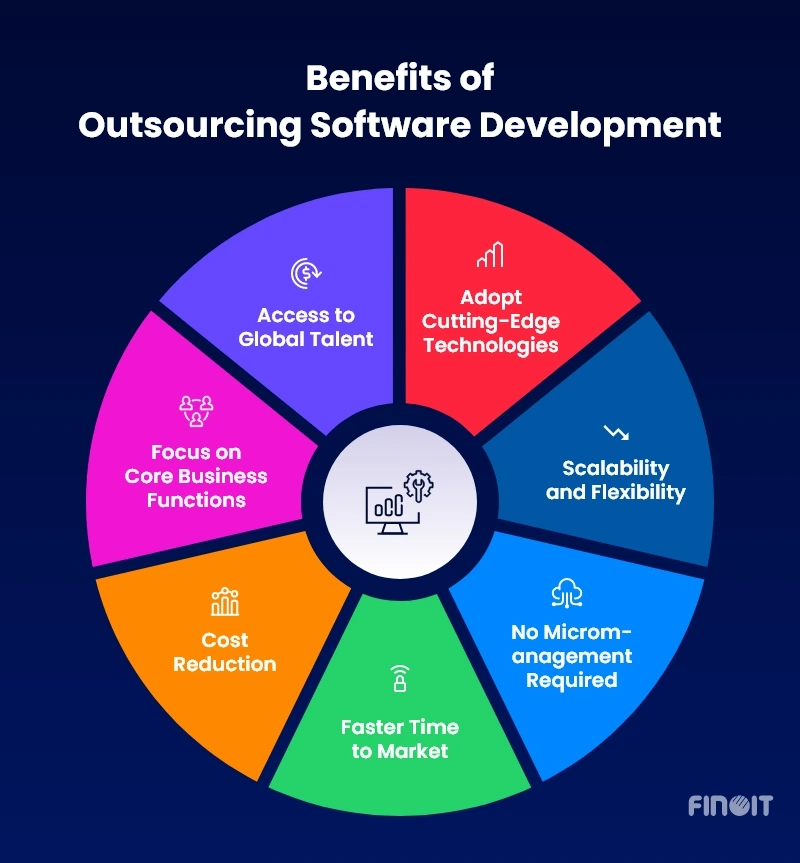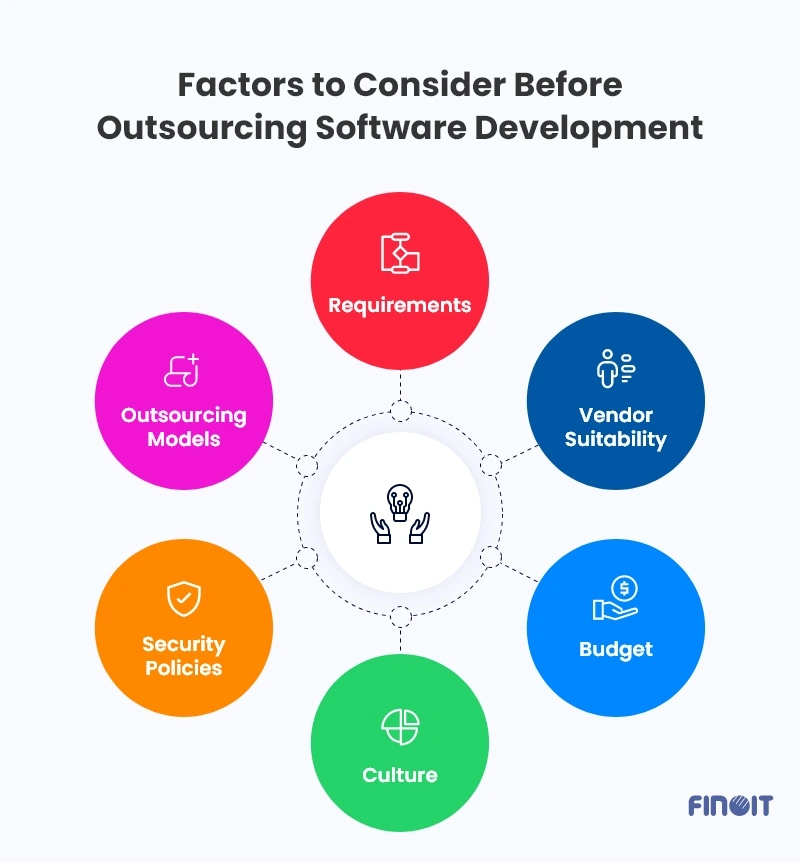Software Development Outsourcing: Benefits, Models, Factors to Consider, and More

Software development outsourcing has transformed into a strategic game-changer for businesses aiming to stay competitive. By delegating software development tasks to external service providers, organizations can realize multiple benefits – they can tap into a global talent pool, cut costs, and delegate the time and costs saved to better their business.
The rise of offshore, nearshore, and onshore outsourcing models has given companies the flexibility to choose the best-fit approach tailored to their unique requirements. As a result, software development outsourcing has become a key practice in the business world. It is constantly growing, and expectedly, will reach USD 124 billion by the end of this decade.
As outsourcing software development has become a key business activity, let’s delve into its every aspect, getting insights that will help you make informed decisions when deciding to outsource your project. Right from its benefits, models, consideration factors, how to select a good outsourcing partner, and trends, we cover everything about the exercise.

Image Source: statista.com
What is Software Development Outsourcing?
Software development outsourcing is the practice of hiring third-party software development firms or teams to work on software development projects that could otherwise be performed in-house. Various reasons prompt this step. The primary one being the need to quickly avail technical resources while minimizing expenses associated with in-house software development.
Benefits of Outsourcing Software Development

Outsourcing software development offers businesses the opportunity to enhance efficiency, reduce costs, and tap into global expertise. Whether you are a startup or an established company, partnering with external development teams can bring numerous advantages. Here are the key benefits of outsourcing software development project that we discuss further:
- Access to Global Talent
- Focus on Core Business Functions
- Cost Reduction
- Faster Time to Market
- No Micromanagement Required
- Scalability and Flexibility
- Adopt Cutting-Edge Technologies
Utilize worldwide talent
The software development outsourcing landscape is evolving continually and is opening the door to a wide range of skilled professionals. Businesses benefit from diverse expertise that may not be available locally and so, countries prefer to outsource to destinations where talent is available at a lower cost as compared to the local talent market. US, Australian and European companies are known to outsource their software development projects by accessing talent in outsourcing markets like Asia (India, Philippines, and Malaysia) and Eastern Europe (Ukraine, Romania, Hungary etc.). These regions offer a wealth of experienced software developers at competitive rates.
Concentrate on core business
While software development is a key process to attain the end objective of digitally transforming a process, top management always wants to focus on the core part of the business rather than being stuck to improving a part of it. By outsourcing software development to well-qualified teams, businesses don’t have to devote extra time to looking into the software development process, as they are promised a commitment of a positive result by the provider.
Reduce operational costs
One of the most compelling reasons for outsourcing software development is availing cost benefit. Outsourcing is known to significantly reduce expenses related to hiring, training, and maintaining an in-house software development team, with a total saving of around 40% to 70%. It also eliminates overhead costs associated with infrastructure, technology, and other operational expenses. This is significant for startups that can save substantial amounts by outsourcing its app development.
Quick launch to market
A good external development team comes with experience and possesses all required resources to complete projects faster, as a result of which software solutions can be quickly deployed. To achieve faster time to market, software development outsourcing has been a key part of strategies of Skype, Slack and other known tech organizations. Instead of landing in the hassles of product development and launching it in the least time, you can simply join hands with experts who have already worked on similar assignments. Such collaborations help you capitalize on new opportunities and respond swiftly to market demands.
No Need for Micromanagement
Professional outsourcing firms manage their teams end-to-end, without your involvement in any way. Outsourcing partners typically have established workflows and management structures in place, ensuring that projects are completed efficiently and to a high standard. This allows the client company to focus on strategic decisions rather than getting involved in the day-to-day management of the team. For example, a healthcare company can outsource the development of its patient management system to a healthcare software development provider to handle the technical details while it focuses on improving patient care services.
Scalability Ease
An essential condition on which outsourcing engagements are based is the flexibility to add or remove resources from the team based on the project’s requirements. If a project phase experiences an increase in the workload, you can request your partner to reinforce the team with additional resources. Conversely, when certain tasks are completed or if the project’s scope changes, you can scale down the team by reducing redundant resources.
Adopt cutting-edge technology
Technological advancements are taking place at a rapid pace. Tools and technological frameworks for building software applications get constantly updated. For instance, Java follows a release cadence, where it receives major updates every six months, while Python receives updates every 18 months. Like this, various other technologies that are used in software development undergo update cycles. Adjusting with this shift and implementing the latest updates is a job of skilled experts. Through outsourcing, you automatically benefit from the latest advancements in technology without investing in training or research.
Models of Software Development Outsourcing
Businesses looking to outsource software development can choose from various models, each offering unique benefits depending on the project’s scope and requirements. These models cater to different geographical, cultural, and operational preferences.
- Offshore Outsourcing
- Nearshore Outsourcing
- Onshore or Domestic Outsourcing
- Hybrid Model
Offshore Outsourcing
In offshore outsourcing, businesses hire development teams from countries that are geographically distant. The model works best to avail cost benefits associated with lower labor costs in certain countries. For example, many Western companies outsource software development to Asian countries like India, China, or the Philippines, or European countries like Belarus, Ukraine, Romania, etc., where skilled labor is available at a fraction of the cost. The approach is particularly advantageous for large-scale projects where cost savings are a priority.
Nearshore Outsourcing
Nearshore outsourcing refers to partnering with companies in nearby countries that fall in the same time zones or the time zone difference is minimal. Alongside cost efficiency, ease of communication and collaboration due to geographical proximity and cultural affinities is another great advantage here. For instance, a company in the United States might outsource to a development team in Mexico or Canada. It also simplifies travel for face-to-face meetings and onsite visits which might be a requirement of the business.
Onshore or Domestic Outsourcing
Onshore or domestic outsourcing is a model where businesses outsource software development to firms within the same country. There are no language or cultural barriers and it also provides greater legal protections. This model is particularly beneficial for projects that require close collaboration and frequent communication. For those businesses operating in regions which are famous as outsourcing destinations, this is a favorable option as they get the required resources at a cost-effective price in their home country.
Hybrid Model
The hybrid model combines onshore, nearshore, and offshore outsourcing strategies to optimize cost, talent, and efficiency. Using it, companies can tailor their outsourcing strategy based on specific project needs and circumstances. Like you can use an onshore team for project management, a nearshore software development partner for implementation, and an offshore team for support. In this way, the hybrid model provides flexibility and maximizes the benefits of each outsourcing model while mitigating their respective challenges.
What are the Factors to Consider Before Outsourcing Software Development

Outsourcing software development is a strategic decision that requires careful consideration of several factors to ensure success. By addressing the following aspects, businesses can effectively manage their outsourcing relationships and achieve desired outcomes.
- Identify Your Requirements
- Search for a Suitable Provider
- Consider the Budget
- Understand the Company Culture
- Review the Security Policies
- Check Outsourcing Models
Identify Your Requirements
Before you decide to outsource, clearly define the scope, objectives, and specific requirements of the software project. Each business develops a particular type of software, where it needs specialized assistance. Start by building a well-outlined project plan to align the outsourcing partner’s capabilities with your business needs.
So, in case you want to develop a mobile app, you should clearly specify to your development partner your target audience, desired features, design preferences, and performance expectations. Detailed requirements help avoid misunderstandings and set clear expectations for both parties, which is important for the outsourcing exercise.
Search for a Suitable Provider
Indeed there are thousands of options available to you, irrespective of which country or region you choose to outsource. Spend quality time to conduct thorough research for finding a provider with a proven track record, relevant experience, and positive client testimonials.
Most importantly, evaluate the technical expertise and domain knowledge of your partner to make sure that it is well-equipped to handle your project. Look for two-fold capability: experience in development as well as experience in your industry. Check references, reviews, and case studies to seek insights into the provider’s quality of work.
Consider the Budget
Everything boils down to your financial capability, as the outsourcing arrangement should fit within your financial constraints. Here, consider both short-term costs and long-term value, including any potential hidden costs, so that you make a sound financial decision.
While an offshore provider may offer lower initial costs, consider other secondary expenses like those related to travel (if involved in the project) etc. in your budget. Evaluate the total cost of ownership (TOC), including software maintenance, updates, and support services. By conducting a comprehensive budget assessment, you will avoid unexpected expenses and successfully make your outsourcing arrangement deliver value for money.
Understand the Company Culture
Cultural compatibility between your company and the outsourcing partner is vital and it should be in terms of work ethics and values. Aligned values and work practices significantly enhance the efficiency and success of the partnership.
Being on the same lines culturally builds a positive working relationship, and eliminates the risk of misunderstandings and conflicts. So, it is important to consider the software development provider’s work ethic, communication style, and approach to problem-solving.
Review the security policies
Security measures and data protection policies of the outsourcing partner should be thoroughly evaluated. Safeguarding intellectual property and sensitive information is important, and also compliance with relevant regulations.
So, if you are a company outsourcing healthcare software development, verify that the provider adheres to HIPAA regulations and has robust data security protocols in place. Conduct a security audit and review the provider’s security certifications to assess their commitment to data protection.
Check Outsourcing Models
It’s essential to understand the engagement models that potential outsourcing providers offer, as these will dictate how the project is managed, billed, and delivered. Common software outsourcing models include fixed-price, time and material, and dedicated team arrangements.
Each model has its advantages and drawbacks depending on the project’s scope, flexibility requirements, and budget constraints. Discuss these models with your potential partner to determine which one aligns best with your project needs and business objectives.
What to Look For in Outsourcing Partner
Choosing the right outsourcing partner is crucial for the success of any software development project. With a multitude of providers available, it’s essential to focus on the following aspects to ensure you select the best fit for your needs.
- Technical Expertise
- Communication Skills
- Project Management Practices
- Reputation and References
- Flexibility and Scalability
- Support and Maintenance
- Legal and Compliance Issues
Technical Expertise
A provider’s technical skills and experience must be relevant to your project. If you are developing an AI-powered application, seek a provider with experience in AI and machine learning. Reviewing the provider’s portfolio, technical certifications, and case studies can help assess their technical capabilities and the number of years spent working on AI.
Look for evidence of their involvement in cutting-edge projects, participation in industry conferences, and contributions to AI research. Providers who actively engage with the AI community bring fresh insights and innovative solutions to your project.
Communication Skills
The outsourcing team should be proficient in preferred language(s) and have robust communication protocols in place to keep all stakeholders informed and aligned. Good communication leaves no scope for misunderstandings, ensures timely issue resolution, and keeps the project on track. Regular progress updates, status reports, and clear escalation paths are all made possible only through smooth communication throughout the project.
Businesses from countries like France and Germany expect proficiency in French and German from developers. However, strong language skills must also be corroborated by clear communication channels, such as email, chat, and video conferencing.
Project Management Practices
Established project management frameworks and methodologies used by the provider are key indicators of their ability to deliver projects on time and within budget. A structured approach to project management brings accountability to the project.
Before you begin, understand how well the provider understands about Agile or Scrum methodologies. Ask if they have PMP certified project managers, or professionals possessing other certifications like PRINCE2. Provider’s project management practices, tools, and techniques must be reviewed on priority.
Reputation and References
Explore all possible channels to understand the reputation of the provider. Look for client references and reviews. Search for reviews received from clients from your industry.
If possible, try to directly connect with past clients to get firsthand insights into the provider’s performance, reliability, and customer service. This is always the best way to get a stamp of confirmation on your decision after you have gone through reviews across all platforms.
Flexibility and Scalability
As we saw, the ability to scale resources up or down based on project demands and adapt to changing requirements is important. Get insights on the team size of the provider. You must get a dedicated team of the required size.
Discuss and understand the approach that the software development vendor offers for onboarding people on demand or descaling the team. Validating the capability is essential as unpreparedness will catch you off-guard. As a result, get a clear idea of the resources, their qualification, and the workload handling capacity of each resource.
Support and Maintenance
The shortlisted provider must offer post-development support and maintenance services, which are essential for the long-term success and sustainability of the software. The provider should offer regular updates, bug fixes, and performance enhancements to keep the software running optimally.
It’s also important to establish clear support protocols, including response times, escalation procedures, and service level agreements. After all, comprehensive support and maintenance services ensure that your software remains reliable, secure, and up-to-date.
Legal and Compliance Issues
There are legalities in software development as brought by local, national, and international regulations, as well as industry-specific requirements. Adherence to legal standards and compliance requirements relevant to your industry and geographic location is non-negotiable. The provider must meet these criteria to protect your business from legal risks and complications.
A company outsourcing financial software development should verify that the provider complies with relevant financial regulations and standards. Review the provider’s legal and compliance frameworks, certifications, and policies to assess how strongly they adhere to compliances.
Future Trends in Software Development Outsourcing
The software development outsourcing sphere is continually evolving. Some trends that expected to dominate in the future are:
Rise of Remote-First Models
Outsourcing firms have begun tapping into a global talent pool to provide clients with access to the best talent regardless of location. The focus will be on providing best-in-class assistance through professionals based out of dispersed locations.
Outcome-Based Contracts
Traditional time-and-materials contracts will give way to outcome-based agreements where payments are tied to the achievement of specific milestones or results.
Growth of Micro-Outsourcing
Instead of outsourcing entire projects, companies will increasingly opt for micro-outsourcing specific tasks or components of a larger project.
Use of Agile Pods
Agile pods, small, cross-functional teams dedicated to specific projects or features, will become more common in software outsourcing arrangements.
Expansion of Multi-Vendor Strategies
Companies will diversify their outsourcing strategies by engaging multiple vendors for different aspects of a project. The approach allows for deriving the best from each, thereby mitigating risk.
Expansion of Nearshoring
Nearshoring, or outsourcing to nearby countries, will gain traction as companies seek to balance cost savings with the advantages of similar time zones and cultural compatibility.
To Wrap Up
Outsourcing software development has proven to be a powerful strategy for businesses as it comes with several positives – optimizes costs, easy access to global talent, amongst others – as we discussed at length.
If you are planning to outsource your software development project, screen and shortlist the best software development companies against the factors we provided.
For any queries or doubts, feel free to connect with our team. With extensive experience of delivering outsourcing services, Finoit has been serving as a trusted custom software development outsourcing partner for businesses worldwide.
